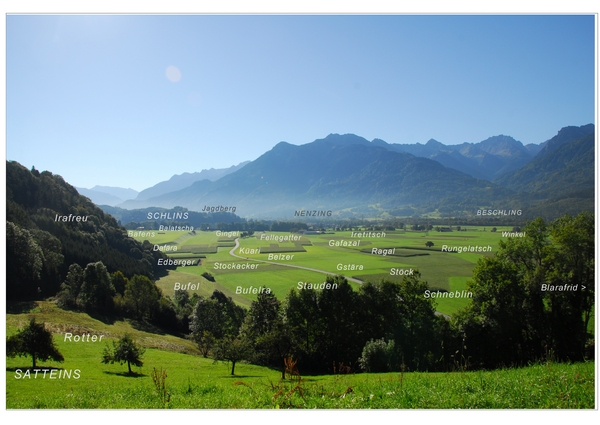Toponyms in Vorarlberg
Oral traditions in Vorarlberg, inscribed 2011
Because land parcels and fields are often located a great distance from farms and villages, their precise geographical designation was of great importance for drawing up contracts, creating route descriptions, and calculating taxes. Over a period of centuries, the resulting toponyms—place names—for specific locations and land parcels became an accepted element of everyday rural life.
The toponyms for all 96 Vorarlberg municipalities are documented and constitute a part of these communities’ linguistic and social-historical cultural heritage. For centuries, these designations were passed down orally from generation to generation. They were given a written form only at the beginning of the 1960s, when these names were in danger of falling into oblivion because of agricultural restructuring.
These toponyms underwent many changes in the course of Vorarlberg’s history. In the sixth century, the Romanic names began being mixed with those of the Germanic-Alemannic immigrants. The names of theses land parcels are thus an important resource for research into the phases of the early medieval settlement of the region between Lake Constance and Arlberg. These names reflect not only the inhabitants’ perception of nature; they also provide historical background and supply information about land use in the past. These historic toponyms today have an identity-building function for the community, as they are based on centuries-old designations.
Contact
Downloads
- Application form (in German only) 31 KB (doc)
- Expertise Erhart (in German only) 891 KB (pdf)
- Expertise Rudigier (in German only) 26 KB (doc)


![[Translate to EN:] © J. Ségur/ZED, with the permission of UNESCO](/fileadmin/_processed_/d/b/csm_Convention-2003-IKE_0832a6a47d.jpg)
![[Translate to EN:] © ÖUK](/fileadmin/_processed_/3/9/csm_P1011318_7eac86402f.jpg)

![[Translate to EN:] © Weitblickfilm](/fileadmin/_processed_/9/8/csm_Workshop_17_2dee1e1fd8.jpg)